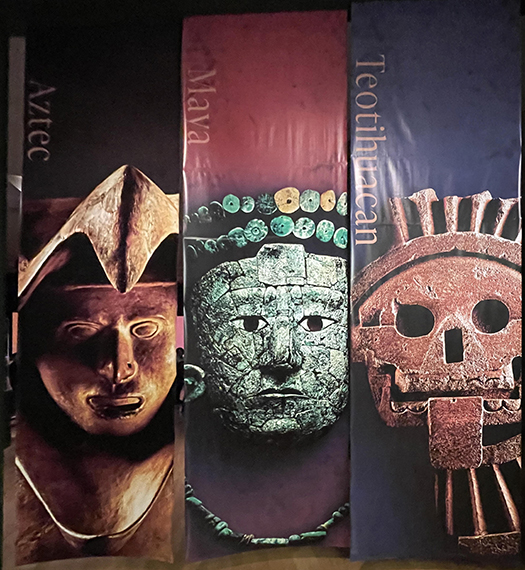
人類というのは7−8万年前に中央アフリカ地域で現生人類が誕生して、その後、アフリカ大陸の大地溝帯生成時期に出アフリカを果たして以降、全世界に拡散していったと言われる。いわゆる「グレートジャーニー」ですね。考古学・人類学でも公知とされている。
そして諸説はあるけれどおおむね3万年前頃には日本列島にも現生人類が到達してきたと言われる。わたしたちの日本人への進化発展はそういった時期からのモノとされている。
で、現生人類の世界進出はその後もシベリア・ベーリング海を超えて北米大陸に到達し、そこからさらに南米大陸まで、ほんの1万年前頃に最終的に到達したのだと言われる。
こういうビッグスパンの人類常識、巨視的に自分たちの国家社会、人間社会を客観的に把握できることが定着してきたというのは、まことに喜ばしい。人間としてこの世に生を受け、こういった認識を客観的基準とできる時代に生きていることに感動します。
で、そういう人類史視点から見ると、北米インディアンとか、中米・南米で花開いた古代文明に対してある種,特別な感覚をもってくるようになる。わたしたちは3万年前くらいにこの日本列島での生活を始めたけれど、そこで別れてなお、はるかな太平洋を環状に回ってアメリカ大陸に到達し、そして徐々に古い友垣は文明を花開かせていった。そういう遠い縁戚意識が濃厚に感じられると思うのです。
そう、はるか昔に生き別れた文明としての兄弟意識のようなものが通底してくる。

地理的には中米メキシコの地域にそういった古代文明が栄えていった。その様子を知らせてくれる展覧会が東京国立博物館で開かれ、刮目させられていたのであります。その展覧会はこの9月3日に終了。その余韻に浸りながら、ときどきその体験、感じたことが繰り返し、胸奥から波のように反芻されてくるのです。
〜いまから13,000年以上前にシベリアからアメリカ大陸にはじめて渡って来た狩猟採集民族は、長い放浪生活を経て大陸を南下しメキシコに到達しました。数千年かけてかれらは変化に富んだ生態系に適応し、多様な動植物を食糧として定住生活を営むようになります。こうして各地に農耕を基盤とした民族集団が形成されました。そのひとつが紀元前1500年頃にメキシコ湾岸部に興ったオルメカ文明。ほぼ同じ頃、メキシコ中央高原やオアハカ地域にも中核的な集落が生まれました。首長たちは記念碑的な建造物を築き、天文学・暦法・文字が発達し、やがて都市が登場します。テオティワカン、マヤ、アステカは古代メキシコ都市文明の代表的な存在です。〜
<展覧会「古代メキシコへのいざない」より>
その顔貌もわたしたち日本人とそう変わらない人物造形感覚をもったかれらの文明と、コトバは通じないまでも、こころで通じ合うことができないか、何回かシリーズ的にちょっと深掘りしてみたいと思います。
English version⬇
Ancient Mexico, the brother civilization of faraway Japan-1
Although we probably knew the way 30,000 years ago, I don’t feel like a stranger. Guided by a sense of human kindred spirits, I would like to share my heart with the ancient Mexican civilization. …
It is said that the present-day humans were born 70,000 to 80,000 years ago in the Central African region, and then spread throughout the world after exiting Africa during the period when the Great Rift Valley was formed. This is the so-called “Great Journey. Archaeology and anthropology are also well-known.
And although there are various theories, it is said that the present-day humans arrived in the Japanese archipelago around 30,000 years ago. Our evolutionary development into the Japanese people is believed to have begun around that time.
After that, it is said that the present humans continued to expand into the world, crossing Siberia and the Bering Sea to the North American continent, and from there to the South American continent, only around 10,000 years ago.
It is truly gratifying to know that we are now able to grasp our national and human societies objectively from a macroscopic viewpoint, using the common sense of humanity in such a big span. I am moved by the fact that we are living in an age when we are born into this world as human beings and can use this kind of recognition as an objective standard.
From this perspective of human history, I have a special feeling toward the North American Indians and the ancient civilizations that flourished in Central and South America. We began our lives on the Japanese archipelago around 30,000 years ago, but even after we parted there, we traveled in a circle around the distant Pacific Ocean to reach the American continent, where our civilization gradually blossomed. I think we can feel a strong sense of such distant relatives.
Yes, there is an underlying sense of brotherhood as civilizations that were separated a long time ago.
And geographically, such ancient civilizations flourished in the region of Central America and Mexico. An exhibition was held at the Tokyo National Museum, and I was astonished to see it. The exhibition ended on September 3. As I soak in the afterglow of the exhibition, sometimes the experience and feelings I had there come rushing back to me like waves from deep within my heart.
〜More than 13,000 years ago, hunter-gatherers first came to the Americas from Siberia, and after a long wandering life, they migrated southward to Mexico. Over several thousand years, they adapted to the varied ecosystems and began to live a sedentary lifestyle, subsisting on a wide variety of plants and animals. Thus, people based on agriculture were formed in various regions of the country. One such example is the Olmec civilization that emerged around 1500 B.C. in the Gulf of Mexico. Around the same time, core settlements also emerged in the central Mexican plateau and Oaxaca region. Chiefs built monumental structures, astronomy, calendar systems, and writing developed, and eventually cities appeared. Teotihuacan, the Maya, and the Aztecs are representative of ancient Mexican urban civilizations. ~…
<From the exhibition “Invitation to Ancient Mexico
We would like to explore in depth the possibility of communicating with the civilizations of these people, who had facial features and a sense of human form that were not so different from those of us Japanese, in a series of exhibitions to see if we can communicate with them in spirit even if not in speech.
Posted on 9月 17th, 2023 by 三木 奎吾
Filed under: 歴史探訪







コメントを投稿
「※誹謗中傷や、悪意のある書き込み、営利目的などのコメントを防ぐために、投稿された全てのコメントは一時的に保留されますのでご了承ください。」
You must be logged in to post a comment.